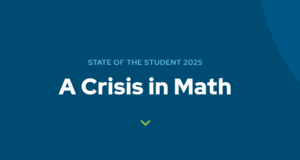By Dale Chu
 The Center on Reinventing Public Education’s new State of the American Student 2025 report delivers a sobering verdict: most states are failing to give parents and the public a clear view of how students are doing in math. At a time when the Nation’s Report Card shows persistent struggles—particularly among historically marginalized groups—state report cards should shed light on the problem. Instead, too often they obscure it.
The Center on Reinventing Public Education’s new State of the American Student 2025 report delivers a sobering verdict: most states are failing to give parents and the public a clear view of how students are doing in math. At a time when the Nation’s Report Card shows persistent struggles—particularly among historically marginalized groups—state report cards should shed light on the problem. Instead, too often they obscure it.
Consider the basics. Only 18 states meet the modest bar of breaking down math achievement and growth data by student subgroup in a way that’s clear and understandable. Thirteen states don’t report any measure of math growth at all, while others bury it in arcane formulas that almost no parent can interpret. The result? Families are left with numbers that offer little insight into whether their children are making progress.
The picture is even bleaker when it comes to having the opportunity to learn math. Thirty-seven states report nothing on whether students are succeeding in algebra or gaining access to advanced math courses. Given how often leaders bemoan an overreliance on test scores, it’s somewhat surprising that more states don’t report this access and opportunity data.
Accessibility is another stumbling block. Just eight states provide report cards that are both clear and easy to navigate, with the ability to compare schools side by side. In most places, parents must wade through scattered websites, opaque charts, or even lengthy PDF glossaries to try and make sense of the information.
Without clear data, parents cannot advocate for their children, educators cannot diagnose gaps, and policymakers cannot allocate resources wisely and target interventions effectively. If the story of the last decade is declining math achievement, the story of today is that states are making it far too difficult to face that reality.
Perhaps it’s time for federal leaders to take a heavier hand. Uncle Sam could prescribe a consistent template that all states must use for their report cards, covering achievement, growth, and opportunity in a way that’s clear and accessible to parents. Without such a standard, transparency will remain optional, and the math crisis will continue to hide in plain sight.
